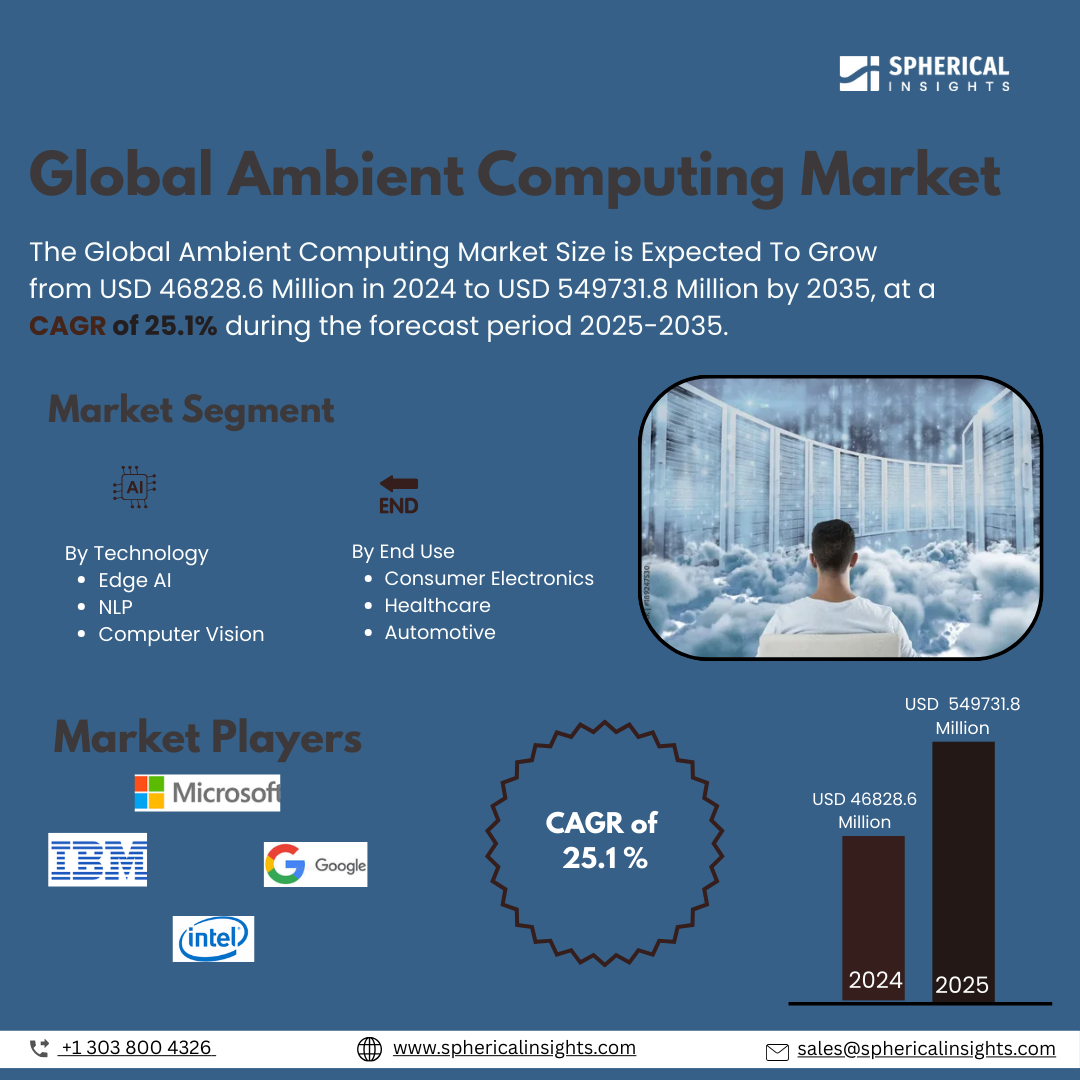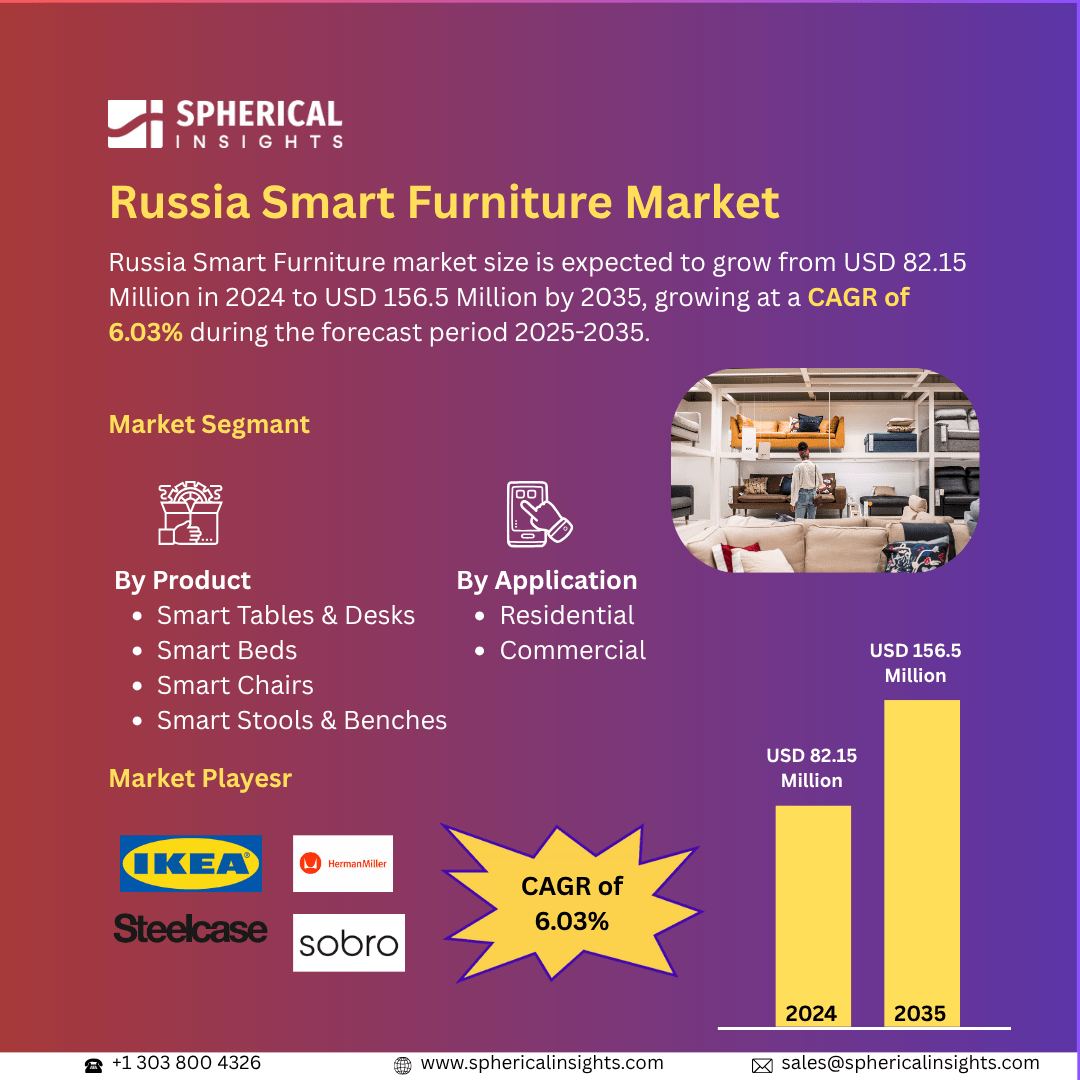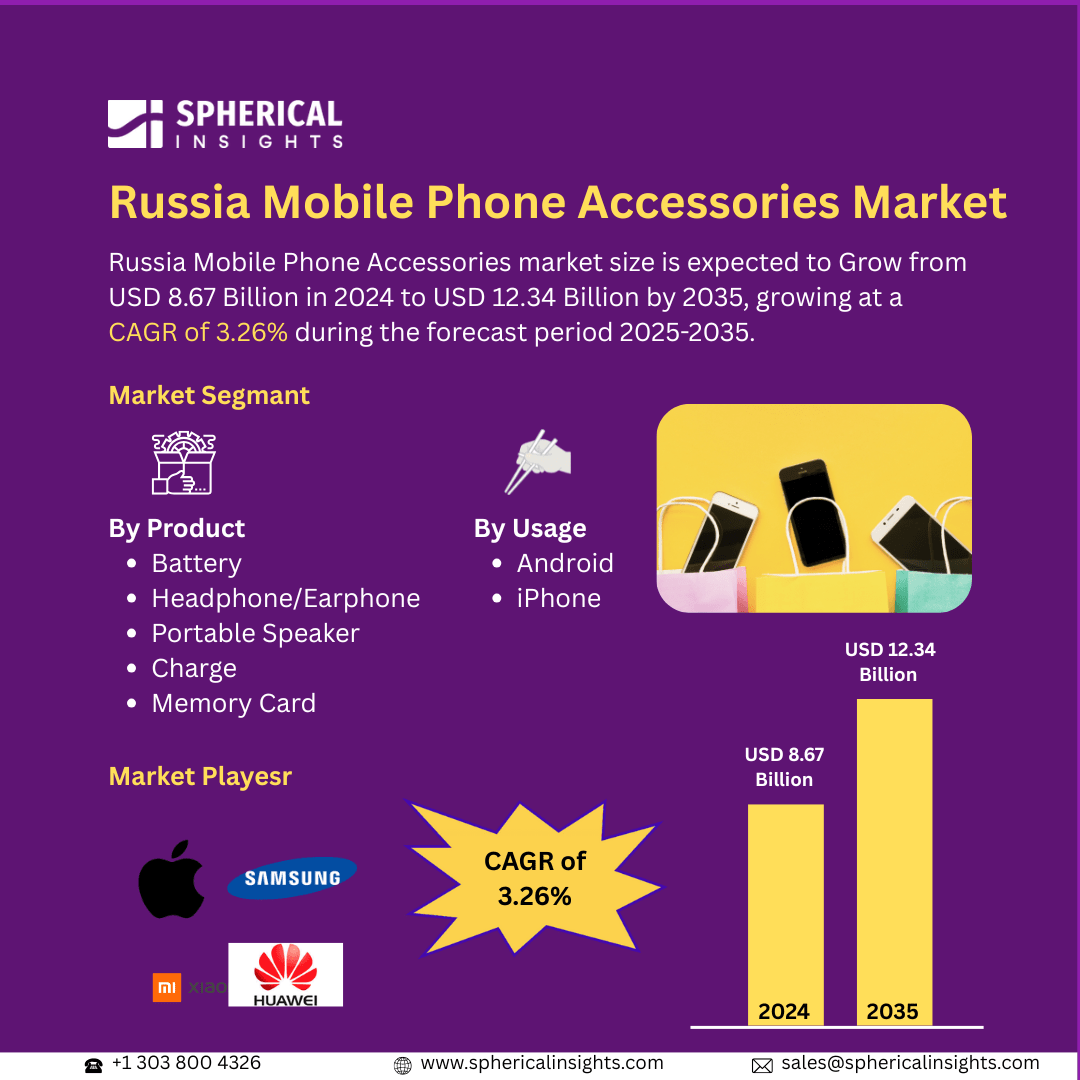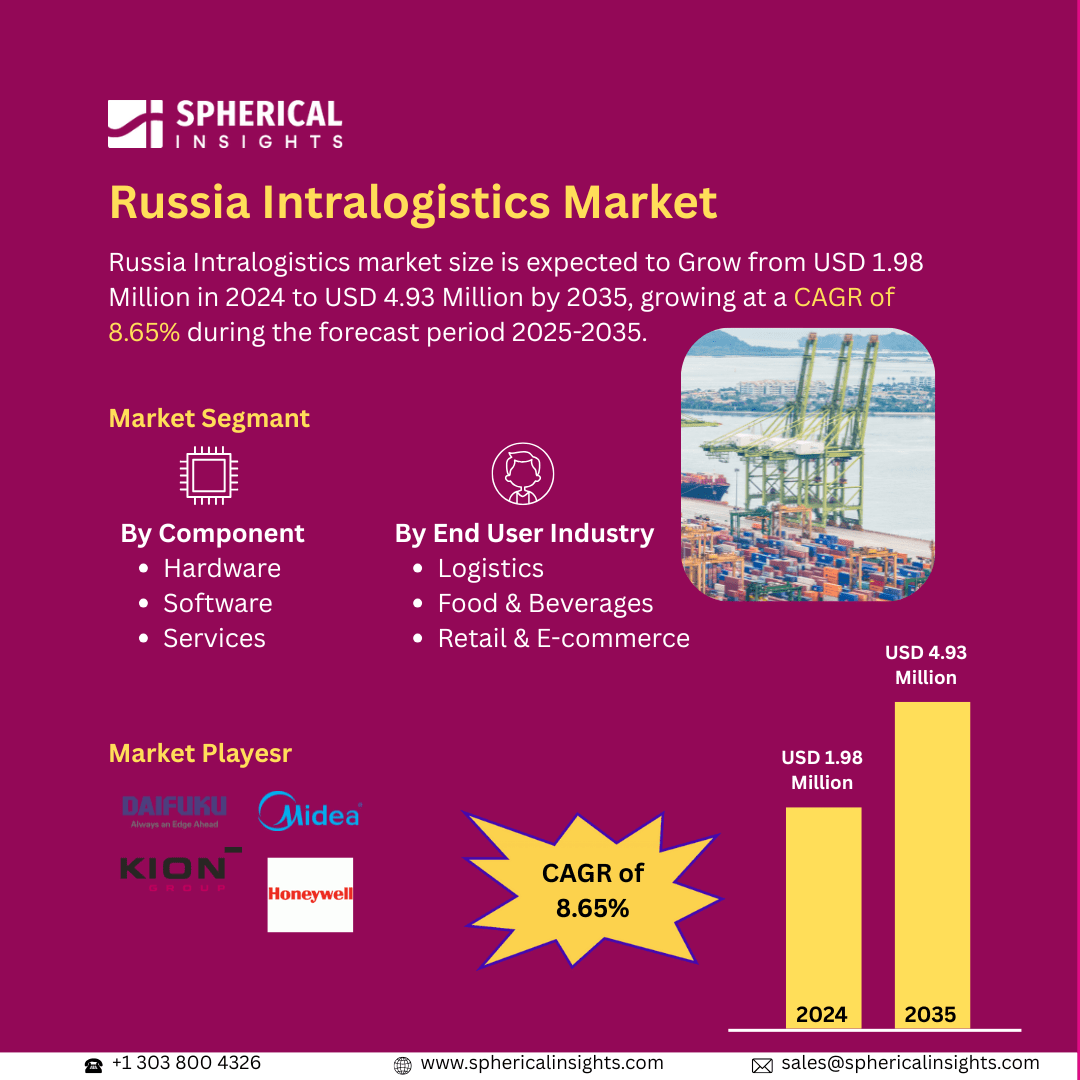Global Ambient Computing Market Insights Forecasts to 2035
- The Global Ambient Computing Market Size Was Estimated at USD 46828.6 Million in 2024
- The Market Size is Expected to Grow at a CAGR of around 25.1% from 2025 to 2035
- The Worldwide Ambient Computing Market Size is Expected to Reach USD 549731.8 Million by 2035
- Asia Pacific is expected to grow the fastest during the forecast period.
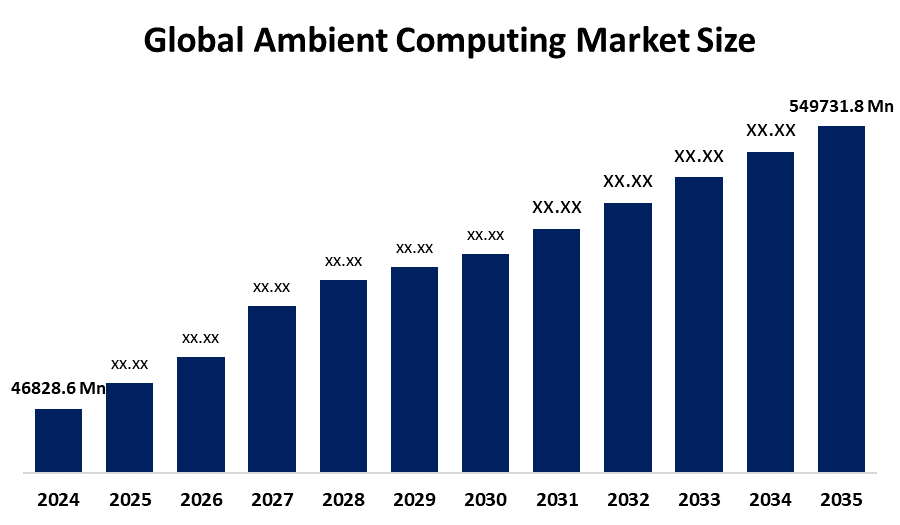
Ambient Computing Market
The Global Ambient Computing Market Size encompasses technologies that enable seamless, intelligent interactions between users and their environment through embedded sensors, AI, and IoT devices. Ambient computing creates environments where devices communicate and respond to users automatically, without the need for explicit commands. This technology integrates voice recognition, context-awareness, and real-time data processing to enhance user experiences in smart homes, offices, and cities. By enabling continuous, unobtrusive computing, ambient computing supports personalized services and efficient automation across various sectors. The market includes software platforms, hardware components, and cloud-based solutions that work together to build intelligent ecosystems. As the digital landscape evolves, ambient computing is poised to revolutionize how humans interact with technology by embedding intelligence into everyday surroundings, making technology more intuitive and accessible.
Attractive Opportunities in the Ambient Computing Market
- Ambient computing’s ability to provide real-time data processing and intelligent automation makes it ideal for industries beyond consumer electronics and healthcare. In education, it can create smart classrooms that adapt to students’ learning styles and needs. Agriculture can benefit from IoT sensors and AI to monitor crops and optimize resources for precision farming. Transportation systems can use ambient computing to improve traffic management, enhance safety, and support autonomous vehicles. This sector expansion opens up new markets and use cases, driving broader adoption and innovation.
- Integrating ambient computing with 5G and edge computing dramatically enhances data speed and reduces latency, enabling devices to respond almost instantly. This is critical for applications requiring real-time decision-making, such as smart city infrastructure managing energy use or traffic flow. Edge computing also allows data to be processed locally, improving privacy and reducing dependence on cloud connectivity. Combined, these technologies enable more efficient, scalable, and responsive ambient systems, fostering new applications and improving user experiences across industries.
Global Ambient Computing Market Dynamics
DRIVER: Businesses are leveraging ambient computing to optimize operations and enhance customer engagement
Increasing consumer demand for personalized and hands-free digital experiences in homes and workplaces is accelerating adoption. Additionally, the proliferation of connected devices and improvements in cloud computing infrastructure provide the necessary support for real-time data processing and seamless device integration. Businesses are leveraging ambient computing to optimize operations and enhance customer engagement, further driving market expansion. Moreover, ongoing innovation in natural language processing and machine learning improves system accuracy, making ambient computing more practical and appealing. These technological breakthroughs combined with a shift toward automation and smart ecosystems are key contributors to the robust growth of the ambient computing market worldwide.
RESTRAINT: Privacy and security concerns are significant barriers
Privacy and security concerns are significant barriers, as ambient computing relies heavily on continuous data collection and real-time monitoring, raising fears over misuse or unauthorized access to sensitive information. The complexity of integrating diverse devices and technologies also poses technical challenges, often requiring significant investment in infrastructure and interoperability standards. High implementation costs can deter small and medium-sized enterprises from adopting ambient computing solutions. Additionally, the lack of widespread awareness and understanding of ambient computing limits user acceptance and adoption. Regulatory and compliance issues related to data protection further complicate deployment, especially across different regions. Lastly, reliability and accuracy concerns such as system errors or misinterpretation of user context can reduce user trust. These factors collectively slow the market’s growth despite strong technological advancements and potential benefits.
OPPORTUNITY: Expanding into new sectors such as education
One key opportunity lies in expanding into new sectors such as education, agriculture, and transportation, where ambient technologies can enhance automation and real-time decision-making. Integration with emerging technologies like 5G and edge computing offers potential for faster, more efficient data processing and reduced latency, improving user experiences. The rise of smart cities initiatives worldwide opens opportunities for ambient computing to contribute to energy management, traffic control, and public safety. Additionally, developing more intuitive human-machine interfaces, including advanced gesture recognition and emotion detection, can unlock new applications and increase user engagement. Partnerships between tech companies and traditional industries provide avenues to create customized ambient solutions tailored to specific needs. Furthermore, growing investments in sustainability and green technologies create prospects for ambient computing to optimize resource usage and reduce environmental impact. These opportunities pave the way for innovation and market expansion beyond current applications.
CHALLENGES: Achieving seamless interoperability among a wide variety of devices
One major challenge is achieving seamless interoperability among a wide variety of devices and platforms from different manufacturers, which is crucial for creating truly connected environments. Ensuring consistent and accurate context awareness is technically complex, as systems must correctly interpret diverse user behaviors and environmental cues in real time. Another challenge lies in managing the vast amounts of data generated by ambient systems, requiring advanced analytics and storage solutions to extract meaningful insights without latency. Designing user-friendly interfaces that balance automation with user control also proves difficult, as over-automation can lead to frustration or loss of trust. Additionally, rapid technological changes require continuous updates and scalability, increasing development complexity. Finally, addressing ethical concerns around consent and user autonomy in environments where computing is pervasive remains a sensitive and ongoing challenge for the industry.
Global Ambient Computing Market Ecosystem Analysis
The global ambient computing market ecosystem includes hardware manufacturers producing sensors and smart devices, and software providers developing AI and context-aware platforms. Cloud service providers supply scalable storage and computing power, while network companies ensure connectivity through Wi-Fi, 5G, and edge computing. System integrators implement solutions across sectors like healthcare and smart homes. End-users drive demand and feedback. Regulatory bodies set privacy standards, and research institutions innovate new technologies. Together, these components fuel the market’s growth and evolution.
Based on the technology, the edge AI segment held the dominant position in the market and accounted for a leading revenue share over the forecast period
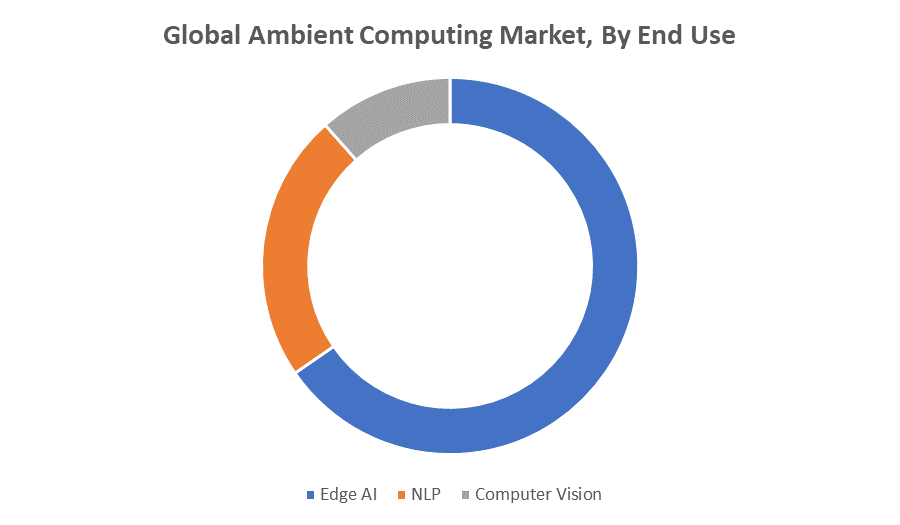
The edge AI segment dominated the ambient computing market due to its ability to process data locally on devices rather than relying solely on cloud computing. This local data processing reduces latency, enhances real-time decision-making, and improves privacy by limiting the amount of sensitive information transmitted over networks. Edge AI enables faster responses in smart environments such as homes, healthcare facilities, and industrial sites, making it highly valuable for ambient computing applications. Additionally, advancements in low-power processors and AI algorithms have made edge AI more efficient and scalable, further driving its leading revenue share throughout the forecast period. This trend reflects the growing demand for intelligent, autonomous systems that operate efficiently even in connectivity-constrained environments.
Based on the end use, the residential segment is expected to grow at the fastest CAGR during the forecast period
The segment growth is driven by increasing consumer adoption of smart home technologies that leverage ambient computing for enhanced convenience, security, and energy efficiency. Devices such as smart speakers, thermostats, lighting systems, and security cameras use ambient computing to create intuitive, automated environments that adapt to user preferences. Rising awareness of connected living, along with falling costs of smart devices and improved internet connectivity, are fueling rapid adoption in households worldwide. Additionally, the push for energy-efficient homes and personalized user experiences further accelerates demand, making the residential segment a key growth area in the ambient computing market.
North America is anticipated to hold the largest market share of the ambient computing market during the forecast period
North America is anticipated to hold the largest market share in the ambient computing market during the forecast period due to its advanced technological infrastructure and early adoption of innovative technologies. The region benefits from the presence of major technology companies, robust R&D investments, and a strong ecosystem supporting AI, IoT, and cloud computing. Additionally, high consumer awareness and demand for smart devices in residential, healthcare, and industrial sectors contribute to market growth. Favorable government initiatives and supportive regulations further accelerate ambient computing adoption in North America, solidifying its leadership position in the global market.
Asia Pacific is expected to grow at the fastest CAGR in the ambient computing market during the forecast period
Asia Pacific is expected to grow at the fastest compound annual growth rate (CAGR) in the ambient computing market during the forecast period. This rapid growth is driven by increasing digitalization, rising disposable incomes, and expanding adoption of smart technologies in countries like China, India, Japan, and South Korea. The region’s large population and growing middle class are fueling demand for smart homes, connected devices, and intelligent automation. Additionally, government initiatives promoting smart cities and IoT infrastructure development support market expansion. Increasing investments by key players and improving internet connectivity further contribute to Asia Pacific’s position as the fastest-growing market in ambient computing.
Recent Development
- In July 2025, OpenAI announced plans to develop AI-first computing devices aimed at creating intelligent, always-on assistants that deeply understand users' environments and preferences. This initiative includes the acquisition of hardware startup io and collaborations with major technology companies to build infrastructure for advanced AI.
Key Market Players
KEY PLAYERS IN THE AMBIENT COMPUTING MARKET INCLUDE
- Microsoft Corporation
- Amazon Web Services (AWS)
- Google LLC
- Apple Inc.
- IBM Corporation
- Intel Corporation
- Samsung Electronics Co., Ltd.
- Cisco Systems, Inc.
- NVIDIA Corporation
- Honeywell International Inc.
- Others
Market Segment
This study forecasts revenue at global, regional, and country levels from 2020 to 2035. Spherical Insights has segmented the ambient computing market based on the below-mentioned segments:
Global Ambient Computing Market, By Technology
- Edge AI
- NLP
- Computer Vision
Global Ambient Computing Market, By End Use
- Consumer Electronics
- Healthcare
- Automotive
Global Ambient Computing Market, By Regional Analysis
- North America
- Europe
- Germany
- UK
- France
- Italy
- Spain
- Russia
- Rest of Europe
- Asia Pacific
- China
- Japan
- India
- South Korea
- Australia
- Rest of Asia Pacific
- South America
- Brazil
- Argentina
- Rest of South America
- Middle East & Africa
- UAE
- Saudi Arabia
- Qatar
- South Africa
- Rest of the Middle East & Africa
